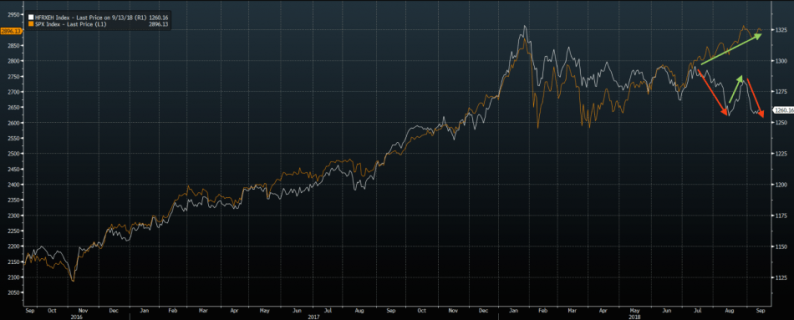Midway through last month, as emerging markets crumbled amid the collapse of the Turkish lira, it became abundantly clear that the dollar needed to take a breather if U.S. equities were going to escape unscathed from the latest bout of EM weakness.
Since March, the effects of U.S. fiscal policy have largely shielded U.S. stocks from turmoil abroad. The tax cuts and late-cycle stimulus catalyzed a buyback bonanza, bolstered corporate bottom lines and supported the U.S. economy even as trade tensions weighed on the global growth outlook.
Meanwhile, the dollar’s ascent on the back of hawkish Fed policy and divergent growth outcomes weighed on vulnerable developing economies, driving EM FX volatility higher and pushing EM stocks into a bear market. By August, the divergence between U.S. equities and the rest of the world was unprecedented on multiple metrics.
Just when it looked like the global malaise might finally be set to boomerang back to Wall Street, Donald Trump took aim at the Fed, Beijing reinstated the counter-cyclical adjustment factor in the yuan fix and Jerome Powell delivered what was generally seen as a dovish speech in Jackson Hole (interpretations vary on that). The dollar took a breather, EM staged a fleeting recovery and with spillover risk thus mitigated, U.S. equities pushed to new highs.
At the same time, the buyside was forced to grab for exposure after underperforming thanks in part to the late July selloff in consensus longs (think: Facebook) and a short squeeze. That scramble to increase exposure conspired with a rally in Growth and Momentum to help close a yawning gap between hedge fund performance and the broader market, although it’s since widened back out as tech regulatory jitters came calling (again).

(Bloomberg)
Well, given what certainly looked like a “melt-up” in late August, some folks are asking JPMorgan how positioning compares with the epic “blowoff top” that unfolded in January just before the VIX spike.












Leave A Comment